|
Some
twenty years ago very few people in the Emirates were
aware of the presence of leopards in the mountains in
the East of the country. Even the fact that there was a
variety of other wildlife there had escaped the notice
of all but the few local people who lived in that area.
In the late eighties there was a spate of killings of
caracals that was noticed by many people because the
killed cats were hung from trees along the roads that
traversed the Hajar and Ru’us al Jibal Mountains. A
caracal is a graceful cat, about as large as a
medium-sized dog, with long legs, a short blunt tail and
pointed ears with tufts of long black hair at the tips.
It is overall orangey-brown in colour and is locally
often called “al-hamr” – the red one. (Another local
name is “fahd” which is actually Arabic for cheetah.)
Because human hunters have
eliminated its original wild prey, such as gazelles and
partridges, this predator cat has to resort to the
killing of the goats and chickens of the farmers, who
try to eke out a living in very inhospitable
surroundings. This does not make the caracals
particularly popular. Even if another animal such as a
feral dog or a fox is guilty of the killing, the cats
are getting the blame. In fact, any large predator that
is spotted is a reason for a hunt to be organized. And
since the mountain farmers are terrific trackers and
marksmen, the hunts are usually successful.
I was told about
the presence of leopards in the UAE as early as 1984.
When in 1989 there were reports of the killing of one
large male leopard in the summer and three leopards in a
cave in the winter, I was sure that this must have been
the last family of leopards to have survived till then.
Not until another leopard was killed and strung up in
1993 did I realise that there might be few more
remaining. Via the newspaper I searched for people who
would be interested in mounting a campaign to save the
Arabian leopard. For the next 10 years the Arabian
Leopard Trust tried to raise public awareness of the
presence of wildlife in the country and of the many
threats that this wildlife faced.
The Arabian
leopard is a subspecies that is only about half of the
size of the better-known African and Indian leopards. A
male will reach 45 kilos, a female only 25. It is much
lighter in colour, with a very light grey skin covered
with black spots in rosettes with brownish centers. The
ears are round and the tail is very long with a black
tip. Among the slate-coloured rocks of the Arabian
mountains it has perfect camouflage. It is probably due
to this fact that any of these large predators has
survived in the bleak Hajar Mountains, where so little
wildlife remains to provide them with food. They have
learned to cope with very little, and will eat anything,
however small. But the main food consists of the goats
that roam all over the mountains. Leopards need water
and are regular visitors at the few permanent water
holes that are hidden in remote valleys and gorges.
Locally the animal is called “nimr”, which is actually
the Arabic word for tiger. Its Latin name is Panthera
pardus nimr.
|
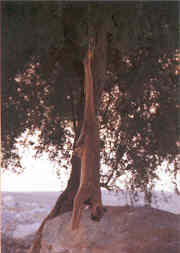 |
|
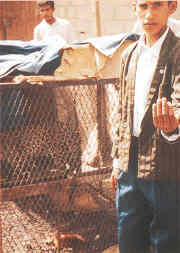 |
|
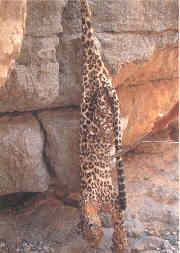 |
|
Caracals strung up on
trees are meant to deter other predators from
catching goats (Photo by J. Peacock) |
|
Arabian leopard in its
cage on a Yemen suq |
|
The picture that started
the Arabian Leopard Trust (by John Gregory) |
In Oman some
leopards had been captive in the Sultan’s breeding
center and a few litters of young had been raised. In
the UAE one male leopard had been caught alive around
1990 and he was living a lonely existence in a sheikh’s
garden.
When the Arabian
Leopard Trust (ALT for short) started its activities,
the following objectives were formulated:
Public awareness
needed to be raised about the existence of wildlife in
the country and about the difficult conditions that this
wildlife had to cope with.
Research had to
be done to find out exactly what was the status of the
various wild animals in the Emirates.
Whatever animals
were already in captivity needed to be brought up
together in order to establish captive breeding groups.
Areas suitable
for nature reserves needed to be identified and proposed
to local governments, so that sometime in the future
wild animals would have a place where they could be
protected from hunting and poaching.
We tackled the
various problems without any experience but with a lot
of enthusiasm. Raising public awareness was easily
combined with raising funds to finance the other
targets. We held family days on the beach or in the
desert with games, concerts, auctions, sponsored runs
and sales of promotional articles. These promotional
articles were designed and produced by ALT committee
members, often helped by local artists who gave freely
of their time and talents.
T-shirts, coffee
mugs, shopping bags and children’s toys were on display
in local supermarkets and made their way into many a
home. The most popular design was that of a leopard face
on a spotted T-shirt with the text: “Don’t say goodbye”.
Some of the ALT
committee members spent all their free time roaming the
mountains talking to the farmers there to pick their
brains about whatever wildlife they knew of and to try
to explain why we wanted to protect this wildlife. Their
visits were not always welcomed, but in the end a small
group of locals from Ras al Khaymah joined the effort
and talked with their tribal members, sometimes even
halting the preparations for a leopard or caracal hunt.
For a while we
tried to raise money with the collection of aluminium
cans. We had some large collecting cages on wheels built
that were placed in schoolyards and next to shopping
centers. The double purpose of cleaning the environment
and doing something to contribute to the saving of the
Arabian leopard inspired hundreds of school children to
collect cans from their homes and surroundings. Large
companies donated money to build the cages and to
process the collections. The full potential of this
effort was never realized, because the collections were
polluted with lots of garbage other than aluminium and
the cost of cleaning the collections and dragging the
collection cages to and from the aluminium factory was
prohibitive. In the end the aluminium collection was
taken over by the Emirates Environmental group.
Many schools and
organizations were involved in the ALT activities or
came up with their own initiatives. Concerts were held,
schools wrote and performed musicals, an international
wildlife art exhibition was held in Sharjah and Dubai,
and desert cleaning trips were organized. All of the
work done and contributions given by the residents of
the country is described in the book “Working for
Wildlife” that is available in some bookshops and at all
libraries and schools throughout the country. (Copies
can also still be requested from the author of this
article)
What was done
with the money that was raised? The first very important
activity was to organize and finance the mountain
research. For this purpose the help was sought of a
husband-and-wife team from South Africa. Chris and Tilde
Stuart had experience tracking and observing wild
animals, including leopards. From 1995 till 1998 they
spent 8 months in total scouring the UAE countryside for
the presence of wildlife, any wildlife. They were not
successful at first in finding any sign of leopards. The
terrain where the leopards lived is incredibly difficult
to negotiate. Leopards usually leave signs like scratch
marks on trees. Here there were almost no trees. The
number of leopards was so small that it was almost
impossible to find scats or the remains of kills. In
fact, there would not be anything left if a leopards
killed a prey here! However, now that it was known
throughout the country that the ALT was interested in
wildlife sightings some information began to find its
way back to us. In the course of the next few years we
were able to map some confirmed leopard and caracal
sightings. The result gave cause for concern. The number
of leopards was assessed at about half a dozen in the
whole area from the Ru’us al Jibal to the southern Hajar
Mountains in Oman. The number of caracals was maybe a
few dozen. Wolves seemed to be extinct. Foxes were still
common. Very, very few gazelles were recorded.
There were a few
exciting moments: very early in the first study campaign
a small mountain fox was caught, photographed and
measured by the Stuarts before being released again.
This turned out to be Blanford’s fox (Vulpes cana),
which had not been recorded in the UAE before. It was
only known from Afghanistan and from Western Saudi
Arabia and southern Oman. After the Stuarts learned to
identify its scats, it turned out to be present in good
numbers. Its presence had remained a secret due to its
terrific camouflage, its shy behaviour and the fact that
it was probably confused with the red fox if it happened
to be seen.
|
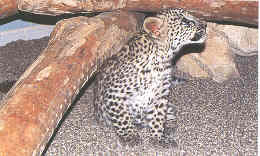 |
|
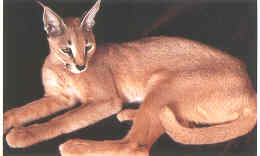 |
|
Andy. the first of now
15 offspring of captive Arabian leopards in Sharjah |
|
The beautiful caracal
(by JF Lagrot) |
The other bit of
good news was the sighting and recording on film of the
rare Arabian tahr (Hemitragus jayakari). This is
a small goat-like ungulate that lives on the steepest
rocky slopes of the Hajar Mountains. It was thought to
have been extinct in the UAE since the early eighties,
but since its re-discovery in 1995 it has been sighted
in various places (including Jebel Hafeet!) in very
small numbers.
Not only wildlife
information came the way of the ALT. We also started
collecting already captive animals, often rescuing them
from horrible conditions. The high point, of course, was
the rescue of a young male Arabian leopard from the Suq
of Sana’a in Yemen. The whole story of this rescue would
take another article. Here I can only mention that after
more than a year of trial and tribulation, Nimrod Felix
(a.k.a. Arnold) arrived in the UAE in May 1995. He was
housed temporarily in custom-built cages in the garden
of one of the ALT-helpers, Christian Gross, a young
Swiss man with knowledge of and heart for wild animals.
“Arnold” was soon joined by a young female on breeding
loan from the breeding group in Oman. The two leopards
got along very well and soon started mating. However, it
took several years before one of the cubs survived:
hand-reared Andy bin Arnold was out first breeding
success.
Breeding caracals
proved to be much more difficult. The first hand-reared
female (rescued after her mother had been shot) was
killed during mating by a male that was on loan from the
Taif Wildlife Centre in Saudi Arabia. The contact with
the wildlife conservation authorities in neighbouring
countries was formalized, first by the ALT in the
Leopard Group of Arabia that held its first meeting in
1995 and 1996 and was later continued by so-called CAMP
meetings at the Sharjah Desert Park.
The target of
establishing captive breeding groups of local wild
animals received a terrific boost when HH Sheikh Sultan
bin Mohammad al Qasimi, the Ruler of Sharjah decided to
develop a desert park dedicated to the natural history
of the region. This Desert Park included a Natural
History Museum, a Wildflower garden, a Breeding Center
for endangered Arabian animals and the Wildlife Centre,
a state-of-the-art zoo.
The Breeding
Centre was opened in May 1998. It seemed huge but the
dozens of cages and enclosures were soon filled with a
great variety of Arabian wild animals. The latest
information that reached me this week was that there are
now 21 leopards present at the Breeding Centre and the
zoo, 15 of which were born there. Absent at the moment
is the "pater familias", Nimrod Felix, who is on
breeding loan in Oman.
The last and very
important target of the ALT was the establishment of
nature reserves in the Hajar and/or Ru’us al Jibal
Mountains. The ALT employed an expert for three years to
work with the local people and the authorities of Ras al
Khaymah in order to prepare the way for the securing of
an area where wildlife could be protected. Unfortunately
time ran out before the target was reached. In 2003 the
ALT handed over to the Worldwide Fund for Nature (WWF)
to continue this effort. WWF is now well-established in
Abu Dhabi and has continued to work on the fundament
that the ALT built earlier.
It is extremely
important that people stay aware that there is wildlife
in the desert, and that its hold on life is tenuous.
Nature reserves can never be a success if the people
living in the area do not participate in the running of
the reserve or even profit from nature conservation
efforts.
In Oman there are
two reserves run on this principle – one for the Arabia
tahr in Wadi Sareen and one in the Jebel Samhan region
in Dhofar for the leopards.
In the coming
spring an interesting project will take place in the
Ru’us al Jibal Mountains in the Musandam Peninsula
(Oman), close to Ras al Khaymah. Three groups of
volunteers will each spend two weeks surveying the
mountains for any sign of wildlife, mapping permanent
water holes and developing ideas for wildlife
conservation in those bleak mountains.
The project is
run by the organization called Biosphere expeditions in
cooperation with the wildlife conservation department of
the Sultan in Oman. Who knows what news will come out of
this effort. May it spell peace and protection for the
unique and beautiful Arabian leopard that is still being
hunted even today! | 